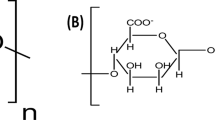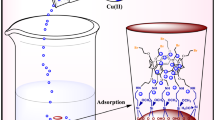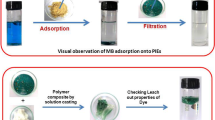Abstract
This study deals with the fabrication and characterization of a pellicular adsorbent appropriate for the expanded bed adsorption (EBA) process. The synthesized adsorbent has an yttria-stabilized zirconia nucleus coated with agarose. Morphological analysis of the coated particles was performed by light-scattering microscopy and showed an average diameter of 197.54 and 202.25 µm, for the nucleus and coated particle, respectively. A screening for the reactive dyes reactive blue 19 (RB19), reactive blue 21 (RB21) and reactive orange 107 (RO107) was performed after immobilization onto the pellicular adsorbent by changing the pH, aiming at finding the binding capacity of these to adsorb bovine serum albumin (BSA). The reactive orange 107 was selected and it was more stable at pH 4.5. Study of the kinetics between BSA and the dye-immobilized particle showed that equilibrium is reached before 1 h. The adsorption isotherm of BSA onto RO107-immobilized adsorbent fitted the Langmuir model showing a qm = 102.328 mg BSA/mL of adsorbent. The pellicular adsorbent also showed good expansion even at a high operating flow rate. Therefore, at a linear velocity as high as 2725 cm/h, a dynamic capacity of 15.7 mg of BSA/mL of adsorbent was obtained.







Similar content being viewed by others
References
Anspach FB, Curbelo D, Hartmann R, Garke G, Deckwer WD (1999) Expanded bed chromatography in primary protein purification. J Chromatogr A 865:129–144
Araújo NK, Pagnoncelli MGB, Pimentel VC, Xavier MLO, Padilha CEA, Macedo GR, Santos ES (2016) Single-step purification of chitosanases from Bacillus cereus using expanded bed chromatography. Int J Biol Macromol 82:291–298
Asgari S, Jahanshahi M, Rahimpour A (2014) Cost-effective nanoporous Agar-Agar polymer/Nickel powder composite particle for effective bio-products adsorption by expanded bed chromatography. J Chromatogr A 1361:191–2028
Asghari F, Jahanshahi M (2012) Fabrication and evaluation of low-cost agarose-zinc nanoporous composite matrix: Influence of adsorbent density and size distribution on the performance of expanded beds. J Chromatogr A 1257:89–97
Asghari F, Jahanshahi M, Ghoreyshi AA (2012) Preparation and characterization of agarose-nickel nanoporous composite particles customized for liquid expanded bed adsorption. J Chromatogr A 1242:35–42
Berger J, Reist M, Mayer JM, Felt O, Peppas NA, Gurny R (2004) Structure and interactions in covalently and ionically crosslinked chitosan hydrogels for biomedical applications. Eur J Pharm Biopharm 57:19–34
Bradford MM (1976) A rapid and sensitive method for the quantitation of microgram quatities of protein utilizing the principle of protein-dye binding. Anal Biochem 72:248–254
Cabanne C, Noubhani AM, Dieryck W, Hocquellet A, Santarelli X (2004) Evaluation of three expanded bed adsorption anion exchange matrices with the aid of recombinant enhanced green fluorescent protein over expressed in Escherichia coli. J Chromatogr B 808:91–97
Cano T, Offringa ND, Willson RC (2005) Competitive ion-exchange adsorption of proteins: Competitive isotherms with controlled competitor concentration. J Chromatogr A 1079:116–126
Carter DC, HO JX (1994) Structure of Serum-Albumin. Adv Protein Chem 45:153–203
Chambers G (1977) Determination of cibacron blue F3GA substitution in blue sephadex and blue dextran-sepharose. Anal Biochem 83:551–556
Chang YK, Chase HA (1996) Ion exchange purification of G6PDH from unclarified yeast cell homogenates using expanded bed adsorption. Biotechnol Bioeng 49:204–216
Chase HA, Draeger NM (1992) Affinity purification of proteins using expanded beds. J Chromatogr A 597:129–145
Chi-Wei Lan J, Hamilton G, Lyddiatt A (1999) Physical and biochemical characterization of a simple intermediate between fluidized and expanded bed contactors. Bioseparation 8:43–51
Conrado LS, Veredas V, Nóbrega ES, Santana CC (2005) Concentration of lactalbumin form cow milk whey through expanded bed adsorption using a hydrophobic resin. Braz J Chem Eng 22(04):501–509
De Lamotte F (2005) Single step purification of a series of wheat recombinant proteins with expanded bed absorption chromatography. J Chromatogr B 818:29–33
Denizli A, Piskin E (2001) Dye-ligand affinity systems. J Biochem Biophys Methods 49:391–416
Fernandez-Lahore HM, Geilenkirchenm K, Nagel A, Kula MR, Thömmes J (2000) The influence of cell adsorbent interactions on protein adsorption in expanded beds. J Chromatogr A 873:195–208
Frej BAK, Johansson HJ, Johansson S, Leijon P (1997) Expanded bed adsorption at production scale: scale-up verification, process example and sanitization of column and adsorbent. Bioprocess Eng 16:57–64
Gonsalves AA, Araujo CRM, Soares NA, Goulart MOF, Abreu FC (2011) Diferentes estratégias para a reticulação de quitosana. Química Nova 34(7):1215–1223
Hamilton G, Luechau F, Burton S, Lyddiatt A (2000) Development of a mixed mode adsorption process for the direct product sequestration of an extracellular protease from microbial batch cultures. J Biotechnol 79:103–115
He L-Z, Gan Y-R, Sun Y (1997) Adsorption–desorption of BSA to highly-substituted dye-ligand adsorbents: quantitative study of the effect of ionic strength. Bioprocess Eng 17:301–305
Hidayat C, Takagi M, Yoshida T (2004) Expanded bed adsorption for purification of alcohol dehydrogenase using a dye-iminodiacetic acid matrix. J Biosci Bioeng 97:284–287
Jahanshahi M, Partida-Martinez L, Hajizadeh S (2008) Preparation and evaluation of polymer-coated adsorbents for the expanded bed recovery of protein products from particulate feedstocks. J Chromatogr A 1203:13–20
Jahanshahi M, Santos ES, Sun Y, Pacek A, Franco TT, Nienow A, Lyddiatt A (2002) Operational intensification by direct product sequestration form cell disruptates: application of a pellicular adsorbent in a mechanically integrated disruption-fluidised bed adsorption process. Biotechnol Bioeng 80(2):201–212
Li P (2006) Proteins Separation and Purification by Expanded Bed Chromatography and Simulated Moving Bed Technology. 236 f. Dissertation. Faculty of Engineering, University of Porto, Portugal
Li P, Xiu GH, Rodrigues AE (2003) Modeling separation of proteins by inert core adsorbent in a batch adsorbent. Chem Eng Sci 58:3361–3371
Lyddiatt A (2002) Process chromatography: current constraints and future options for the adsorptive recovery of bioproducts. Curr Opinion Biotechnol 13:95–103
Lyddiatt A, O’sullivan D (1998) Biochemical recovery and purification of gene therapy vectors. Curr Opinion Biotechnol 9:177–185
May T, Pohlmeyer K (2011) Improving process economy with using expanded-bed adsorption technology. Bioprocess Int 9:32–36
Mccormick DK (1993) Expanded bed adsorption. The first new unit process operation in decades. BioTechnology 11:1059
Miao ZJ, Lin DQ, Yao SJ (2005) Preparation and characterization of cellulose-stainless steel powder composite particles customized for expanded bed application. Indus Eng Chem Res 44(22):8218–8224
Moraes CR, Mazutti MA, Rodrigues MI, Filho FM, Kalil SJ (2009) Mathematical modeling and simulation of inulinase adsorption in expanded bed column. J Chormatogr A 1216:4395–4401
Padilha CEA, Padilha CAA, Souza DFS, Oilveira JA, Macedo GR, Santos ES (2017) Recurrent neural network modeling applied to expanded bed adsorption chromatography of chitosanases produced by Paenibacillus ehimensis. Chem Eng Res Des 117:24–33
Palsson E, Gustavsson PE, Larsson PO (2000) Pellicular expanded bed matrix suitable for high flow rates. J Chromatogr A 878:17–25
Rezvani A, ·Jahanshahi M, Asghari F (2014) Characterization of a novel agarose–nickel composite matrix for protein nanoparticles affinity chromatography in expanded bed. Chromatographia 77:1267–1274
Richardson JF, Zaki WN (1954) Sedimentation and fluidisation: Part I. Trans Inst Chem Eng 32:35–53
Santos ES, Guirardello R, Franco TT (2002) Preparative chromatography of Xylanases using expanded bed adsorption. J Chromatogr A 944(1–2):217–224
Sousa Júnior FC, Padilha CEA, Chibério AS, Ribeiro VT, Martins DRA, Macedo GR, Santos ES (2016) Modeling and simulation of breakthrough curves of recombinant 503 antigen using immobilized metal affinity expanded bed chromatography. Sep Purif Technol 164:34–40
Sousa Júnior FC, Vaz MRF, Padilha CEA, Chibério AS, Martins DRA, Macedo GR, Santos ES (2015) Recovery and purification of recombinant 503 antigen of Leishmania infantum chagasi using expanded bed chromatography. J Chromatogr B 986–987:1–7
Sun Y, Pacek A, Nienow A, Lyddiatt A (2001) Fabrication and characterisation of a novel pellicular adsorbent customised for the effective fluidised bed adsorption of protein products. Biotechnol Bioprocess Eng 6:419–425
Thömmes J, Weiher M, Karau A, Kula M-R (1995) Hydrodynamics and performance in fluidized bed adsorption. Biotechnol Bioeng 48:367–374
Toledo, AL; Jr, Severo JB, Souza RR, Campos ES, Santana JCC, Tambourgi EB (2007) Purification by expanded bed adsorption and characterization of an amylases FORILASE NTL® from A. niger.. J Chromatogr B 846:51–56
Tong X, Sun Y (2001) Nd–Fe–B alloy-densified agarose gel for expanded bed adsorption of proteins. J Chromatogr A 943:63–75
Xia H, Lin D, Yao S (2007) Spherical cellulose-nickel powder composite matrix customized for expanded bed application. J Appl Polym Sci 104:740–747
Zhou X, Shi QH, Bai S, Sun Y (2004) Dense pellicular agarose-glass beads for expanded bed application: fabrication and characterization for effective protein adsorption. Biochem Eng J 18:81–88
Acknowledgements
The authors thank the CAPES and CNPq for the financial support.
Author information
Authors and Affiliations
Corresponding author
Ethics declarations
Conflict of interest
The authors declare no conflict of interest.
Ethical approval
This article does not contain any studies with human participants or animals performed by any of the authors.
Electronic supplementary material
Below is the link to the electronic supplementary material.
Rights and permissions
About this article
Cite this article
de Araújo Elpídio, C.M., de Araújo Padilha, C.E., de Sousa Júnior, F.C. et al. Fabrication and Characterization of a Dye-Immobilized Yttria-Stabilized Zirconia Pellicular Adsorbent for Expanded Bed Adsorption Chromatography. Chromatographia 81, 1355–1364 (2018). https://doi.org/10.1007/s10337-018-3581-6
Received:
Revised:
Accepted:
Published:
Issue Date:
DOI: https://doi.org/10.1007/s10337-018-3581-6




